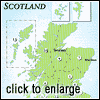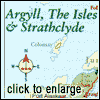|
The Kintyre Peninsula
The mid-Argyll market town of Lochgilphead marks the
start of a tour of the Kintyre Peninsula. This is a hub for the smaller communities
nearby, with provisions such as the only bank and supermarket for some distance.
 From Loch Crinan on the west side of the peninsula to Lochgilphead
the Crinan Canal cuts through. Built at the end of the eighteenth century it remains
as an engineering monument, and is much used by yachts or the sporadic puffer plying
the passage from the Clyde to north-west Scotland. 9 miles (14km) long and with fifteen
locks, the canal was complete in 1809. From Loch Crinan on the west side of the peninsula to Lochgilphead
the Crinan Canal cuts through. Built at the end of the eighteenth century it remains
as an engineering monument, and is much used by yachts or the sporadic puffer plying
the passage from the Clyde to north-west Scotland. 9 miles (14km) long and with fifteen
locks, the canal was complete in 1809.
The A83 continues along the mouth of Loch Fyne to
Tarbert before crossing to the western side of Kintyre. To the west is the more diminutive
lump of Knapdale, a quiet, less trampled corner. There is a circular route worth
taking, the B8024. It is a delicate environment here with admirable views over to
Jura and Islay, and its main focus is usually Loch Sween with its Castle Sween to
the north.
The fishing village of Tarbert appears idyllic as
the road descends into town. This is the terminal end of the deep West Loch Tarbert
and each morning small fishing trawlers head out to the seas surrounding the Inner
Hebrides. If not for the thin stretch of land inhabited by Tarbert, Kintyre would
be an island.
There is a rubble-reduced castle above the town called
Bruce's Castle, but the best way to employ your time here is to walk out by the loch
and enjoy the peace. The Columba Hotel is one of the cosiest with mesmerising views
over the loch. This serves also some of the best bar meals in town.
Just south of Tarbert on the A83 is the ferry terminal
of Kennacraig which serves the Inner Hebridean islands of Islay, pronounced 'Isla',
and Jura. It is a two hour crossing to Port Ellen on Islay, some 25 miles by 20 miles
(40km by 32km) and the most southern of the Inner Hebrides.
Islay and Jura
 In medieval times this was the power base for the Lords of
the Isles who ruled Scotland's western seaboard and conducted a fairly independent
existence from the rest of Scotland. In medieval times this was the power base for the Lords of
the Isles who ruled Scotland's western seaboard and conducted a fairly independent
existence from the rest of Scotland.
For today's visitors the southern shores of the island
around Port Ellen could offer all they might need with three world famous whisky
distillers and a unique 18 hole golf course. It is possible to fly to Islay from
Campbeltown on Kintyre or from Glasgow Airport with the airport being minutes away
from the Machrie Hotel and Golf Course.
Islay Whiskies are in the premier division of Scotland's
malt industries. The strong, peaty, smoky flavour of Islay whisky comes about with
the peat burning process and the sea air in which they are stored giving them a tinge
of iodine. Bowmore, Lagavulin, Laphroig and Bunnahabhainn are produced here, and
each distillery offers tours and samples of their produce. There are a total of eight
distilleries on the island.
Near Port Ellen is the island's most important artifact,
the Kildalton Cross; made more than 1,200 years ago, it is inscribed with early Christian
symbols and is unlike the cross found in Iona's cathedral.
Bowmore, further north on the A846, was the capital
of the island. It is another distillery town with its whisky production established
in 1779.
Overlooking Loch Indaal is a 200 year-old round church,
which was designed to do away with corners in which evil spirits could hide.
Around the bay is Port Charlotte with is Museum of
Islay Life set in a converted church. There are examples of craft working tools,
a maritime section and information of the standing stones and burial cairns of the
area.
Islay is popular with bird-watchers, especially around
the sandy bay at Craigens. Fishing for trout and salmon is excellent in the many
rivers and lochs and there is easy accessibility to sea angling. Islay's importance
as a medieval centre was focused around Finlaggan Castle, a seat of the MacDonalds
and now a mossy ruin just off the road before Port Askaig.
From Port Askaig there is a short ferry hop to the
neighbouring island of Jura.
Jura is not developed with only one 24 mile (39km)
long, single track road and very few people. The majority of the island is only accessible
by foot. This may be why Eric Blair (otherwise known as George Orwell) chose it as
an escape to write his novel 1984. Towards the headland is the Gulf of Corryvreckan
where an infamous whirlpool occurs at certain tides capable of swallowing whole boats.
Deer are abundant around the Paps of Jura, two breast
shaped rises that dominate the skyline. Bird watching and gentler walks are the main
activities on Jura. There is the Craighouse Distillery producing Jura malt whisky
in the island's main centre of Craighouse where there is also a hotel and general
store-come-post office, a tea-room and hairdresser.
Gigha
Returning to the mainland there is the ferry terminal
for Gigha at Tayinloan.
Washed by the Gulf Stream, fertile Gigha is the tiny
island between Kintyre and Islay best known for its cheese. Arminish is the main
centre. The island has changed hands several times since being sold by its original
laird. One buyer was Sir James Horlick of hot-drinks fame who established the marvellous
garden at Achamore House.
Taking the roller-coaster road, the B8001 brings you
to the desolate little landing for the Claonaig to Lochranza ferry on the island
of Arran. If there is nobody else there, wait around and eventually more cars or
the ferry will arrive.
There is a choice of traversing the Kintyre peninsula,
either by the main A83 which is fast and relatively scenic or by the tortuous B842
following the east coast, much demanding and more rewarding with leafy twists and
wide views over to the mountainous side of Arran.
You eventually reach the village of Carradale which
has a delightful little harbour and a testing 9 hole golf course. There are walks
through Carradale Forest and out to Carradale Point. Carradale Hotel with the golf
course adjacent, offers golf breaks where you stay at the hotel and play free golf,
as well as a leisure club, two squash courts, sauna and solarium with occasional,
large-screen film shows. Carradale House Gardens are walled gardens dating from about
1870.
Campbeltown and the south
Campbeltown is the central municipality for the area,
a former herring fishing port and once hub of assiduous whisky production, so recalling
the song 'O'Campbeltown Loch, I wish ye were whisky'. Only two whisky distilleries
are now left in the area, but at one time there were a total of thirty-four such
businesses in and around town.
A fourteenth century cross graces the only round-about
in town in front of the harbour and Tourist Information Office. There is a small
museum in the local library with some local exhibits. Campbeltown Creamery on Witchburn
Road produces and sells 'Truckle' which is a mature cheddar wrapped in wax and worth
taking away.
Perhaps the most popular attraction in this area is
a cave on Davaar Island which lies off Kildalloig Point east of town. Before heading
out check with the tourist office the times of the safe walking tide. A single spit
connects the island with the mainland and here, in a cave, a painting appeared in
the late 1800s of the crucifixion, lit only by a shaft of light from above. It was
not until 1934 that the artist owned up; a local man called Archibald MacKinnon.
Continuing south on the B842 leads through the Mull of Kintyre,
another area made famous in song when Paul McCartney of The Beatles retreated here.
The coastal town of Southend is set south of some of Kintyre's best scenery but the
village does little to augment the natural scene. Dunaverty Rock was the site for
Dunaverty Castle, now no longer in existence.
Back to the mainland

The return drive from Mull of Kintyre and Campbeltown
along the A83 to Inverary or Oban can seem tedious as you are forced to back-track
along the A83. Alternatives back to Scotland's central belt exist, for example by
taking the minor B842 from Campbeltown to Claonaig, a windy and lumpy road but with
fine views of the west side of the island of Arran.
During the summer months a ferry crosses from Claonaig
to Lochranza on the north tip of Arran, from where you can drive down to Brodick
on the island's east side and take another short ferry crossing to Ardrossan on the
mainland, some 30 miles (48km) south-west of Glasgow. With the cost of the ferries,
this method is rather more expensive but it avoids a long drive and gives you the
chance to see the beautiful island of Arran.
|



